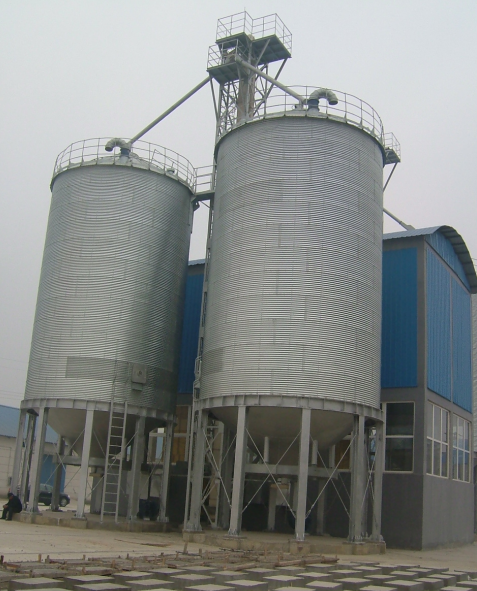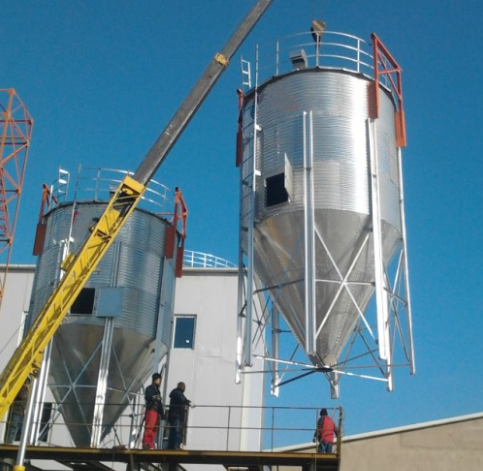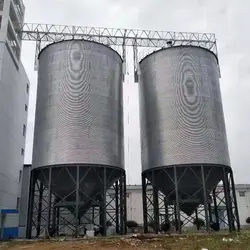Steel Silo
Steel Silo
World-leading food storage solutions. ANON sells steel silos globally with a total capacity to store approximately 300,000 tons of grain. As a premium agricultural machinery manufacturer, we provide high-quality grain storage and preservation solutions to support the sustainable development of the grain industry.
Choose the right product for you
Providing quality products and services.
ANON’s steel silos are large storage containers assembled from high-strength steel plates using interlocking seams or bolted connections. They are suitable not only for storing grain and feed but also for bulk materials such as oilseeds, chemical raw materials, and cement. We offer various types of steel silos, including bolted steel silos, welded steel silos, and spiral steel silos.
Steel silos have become the preferred steel structure containers for bulk material storage due to their large capacity, high strength, rapid construction, and excellent sealing properties.
Bolted Steel Silos:
Bolted steel silos are assembled using galvanized corrugated steel plates connected by high-strength bolts. They are disassemblable and reconfigurable, making them suitable for temporary storage or relocation needs. They offer lower strength per unit area compared to other silo types, but are more cost-effective.
Welded Steel Silos:
The silo body is fabricated by welding steel plates on-site or in a factory. They offer the best airtightness, making them suitable for high-pressure or liquid storage such as sulfuric acid and edible oil. These silos feature large capacities.
Spiral-Formed:
Spiral-formed steel silos are created by continuously rolling steel plates using specialized equipment, interlocking them to form an integrated silo body. They provide high sealing performance, enabling storage of powdered materials like cement and fly ash, and exhibit strong seismic resistance.

We also offer flat-bottom and cone-bottom styles.
Flat-bottom steel silos feature a level base requiring discharge via scraper conveyors or bucket elevators. They achieve extremely high emptying rates, with airflow ensuring material moves seamlessly toward the outlet without dead zones, leaving minimal residue. Ideal for large-capacity grain storage.
Cone-bottom steel silos feature a tapered base. Material naturally flows toward the discharge port at the bottom, guided by its own weight and the inclined funnel surface. This design is suitable for smaller storage capacities or applications requiring frequent loading and unloading.
We provide end-to-end project design, manufacturing, and installation services. Simply share your storage capacity requirements, land area specifications, and other detailed needs. We will create customized drawings and produce components according to your specifications. Upon material delivery to your site, our engineers will oversee subsequent construction and installation. Rapid construction ensures final product quality.
Whether you’re in the grain industry or other manufacturing industries requiring large-volume material storage, our steel silos can meet your needs. Simply tell us your requirements, and we’ll design and build a suitable steel silo. We offer one-stop services for agricultural machinery, from plowing, sowing, harvesting, and subsequent processing. If you also require processing machinery, such as rice mills, our extensive product range can significantly reduce your supplier search time.

FAQ
1. What is the difference between a silo and a warehouse?
Silos store grain vertically, while warehouses store grain horizontally. Using steel silos instead of warehouses for grain storage has many advantages: first, they take up less floor space.
2. What is the service life of a silo?
Grain silos typically have a service life of approximately 30 years or more; therefore, when selecting a grain storage system, thorough calculations should be made and the farm’s actual needs should be fully considered.
3. Are steel silos suitable for very wet mineral powders or explosive grain dust?
Most bulk materials are suitable, but special materials require specialized designs.
For wet materials, the silo walls must be reinforced with corrosion protection, and the design must take into account the material’s angle of repose and flowability; A more robust arch-breaking discharge device must be installed.
For explosive dust, explosion vent panels and necessary safety monitoring systems must be installed, and all equipment must be explosion-proof.
Corrosive materials require a higher-grade anti-corrosion coating or stainless steel.
4. What is the approximate total cost of building a steel silo?
This is a complex question with no standard answer. Cost depends on capacity and size; larger silos are more expensive. Screw silos and prefabricated silos may have lower unit prices, while welded silos may cost more due to the large amount of steel used and complex construction. Supporting systems also determine price. The level of automation (temperature measurement, material level control systems), dust collector, and discharge system selection significantly impacts the total price. Furthermore, foundation and construction conditions: poor geological conditions and remote construction locations can increase costs. It’s usually necessary to inquire with suppliers based on specific plans.
5. What are the causes and solutions for material discharge difficulties in steel silos?
Potential causes include a damaged or improperly operated vent discharge solenoid valve, pipe blockage, and compacted or compacted material.
Solutions include replacing damaged solenoid valves, checking the condition of related valves, and ensuring fluidization; regularly checking for blockages, increasing pipe air pressure, and optimizing pipe design; regularly loosening the material, arranging storage time, and optimizing material management.
6. Why do silos collapse?
Silos can collapse due to a variety of factors, including improper design and construction, structural damage from corrosion or aging, operational errors (such as overloading or improper loading), and external forces such as strong winds, earthquakes, or fire. These potential issues can weaken the silo’s structure, leading to critical failure points or even catastrophic collapse of the entire silo.
7. What are the key points for steel silo maintenance?
Regular maintenance is essential when using a steel silo. After each filling or emptying, inspect the silo walls for deformation, paying particular attention to areas such as the outriggers. Annually, perform anti-corrosion treatment on the silo walls and inspect the base of the cone bucket for rust. When emptying the silo, verify that the door seals are free of cracks and promptly replace any aging seals. Clean the dust collector on the roof monthly to prevent clogging. Also, monitor the material status in real time using a level meter and temperature sensor. Quarterly, check the air pressure and fluidizing rods in the pneumatic discharge system. Contact us promptly if any abnormalities are detected. This ensures the long-term safe and stable operation of the steel silo.
Contact for detailed service
Anon cooperates with a number of factories to improve efficiency and service quality, and provide technical support and services to customers.
Get Support
